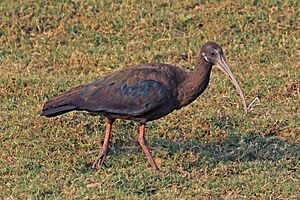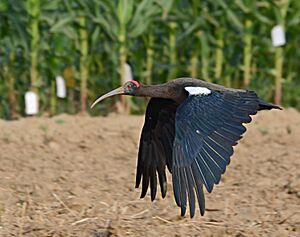Red-naped ibis facts for kids
Quick facts for kids Red-naped ibis |
|
|---|---|
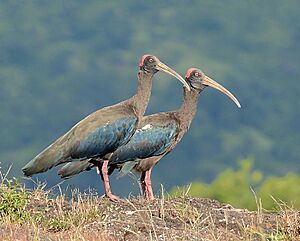 |
|
| A pair | |
| Conservation status | |
| Scientific classification | |
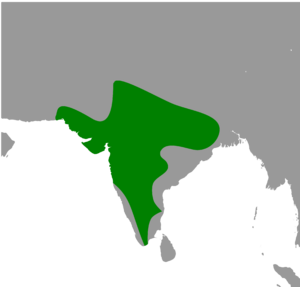 |
|
| Approximate distribution range | |
| Synonyms | |
|
Inocotis papillosus |
The red-naped ibis (Pseudibis papillosa), also called the Indian black ibis or black ibis, is a type of ibis bird. You can find it in the flat lands, farms, and cities of the Indian Subcontinent. Unlike many other ibises, it doesn't spend a lot of time near water. Instead, it prefers dry fields, though it is still drawn to areas with more wetlands. These birds are usually seen in pairs or small groups. You can spot them by their mostly dark body, a white patch on their shoulder, and a bare dark head with a bright red, bumpy patch on top and back of the head. They are quite loud, especially when they are nesting. They often build their nests high up in large trees or on cell phone and electricity towers.
Contents
What Does the Red-Naped Ibis Look Like?
The red-naped ibis is a big black bird with long legs and a long, curved beak. Its wing feathers and tail are black with a shiny blue-green color. Its neck and body are brown and not shiny. A clear white patch stands out on its shoulders. The top of its head has no feathers, but instead has a bright red, bumpy patch. This bumpy patch, called a caruncle, is shaped like a triangle and grows on adult birds. Its eyes are orange-red.
Both male and female ibises look the same. Young birds are browner and don't have the bare, red-patched head at first. Their beaks and legs are grey, but they turn reddish during the breeding season. Their toes have a small fringe and are slightly webbed at the bottom.
These birds are usually quiet, but they call out at dawn and dusk, and even more when they are nesting. Their calls are loud, braying, and squealing sounds that get quieter. They rarely call at night, but it has been seen in cities.
Sometimes, people might confuse this bird with the glossy ibis from far away. However, the glossy ibis is smaller, likes to be in bigger groups, stays near wetlands, and doesn't have the white patch on its wing or a bare head.
How the Red-Naped Ibis Got Its Name
The red-naped ibis was first given its scientific name, Pseudibis papillosa, by a scientist named Temminck in 1824. For a while, it was placed in a different group, but then it was moved back to the Pseudibis group.
This species used to include another bird, the white-shouldered ibis, as a subspecies. But now, scientists consider the white-shouldered ibis a separate, though closely related, species. The main difference between them is on their heads and necks. The red-naped ibis has a patch of red bumps on the back of its head, which the white-shouldered ibis doesn't have. Also, adult red-naped ibises have a narrow, bright red area on the top of their head that gets wider at the back. The white-shouldered ibis has a bare, pale blue area on the back of its head and upper neck that forms a full collar.
Where the Red-Naped Ibis Lives
The red-naped ibis lives across the flat areas of the Indian Subcontinent. In Rajasthan, you can often see them near the Aravalli mountains, but they don't use the trees on the mountains themselves. These ibises live in lakes, marshes, riverbeds, irrigated farms, dry empty fields, villages, towns, and cities. More wetlands in an area attract more red-naped ibises, but the birds mostly look for food in dry fields. They use wetlands more for foraging during the summer. In dry areas, they are often seen in small groups of 2-4 birds, which might be families. Larger groups are not as common. Fewer ibises are found in wetter places and seasons.
They are common birds that live and breed in Haryana, Punjab, Rajasthan, and the Gangetic plains. They also live in southern India, but not in the forests or the very dry areas of the far southeast of India or Sri Lanka. In lowland Nepal, most red-naped ibises looking for food were seen in farm fields, but most nests were found in forests. Red-naped ibises often use villages, towns, and big cities to find food, nest, and rest.
The red-naped ibis mostly looks for food and does other activities during the day. At night, they rest together in groups on trees or islands. It's rare for them to be active or call loudly at night.
What the Red-Naped Ibis Eats
Scientists have studied what red-naped ibises eat by looking at their stomach contents. Their diet includes small water animals like prawns and crabs, insects like beetles, grasshoppers, and crickets, and even scorpions, dead animals, and frogs. More recent observations show that the red-naped ibis eats many different things. They eat dead animals, insects, frogs, other small animals, and grains.
They mostly look for food in dry, open land and fields with short leftover stalks. Sometimes, they join egrets and other birds in fields being plowed to eat earthworms and insects that are uncovered. They also dig for beetle grubs. They walk around and, like other ibises that feel for food, they probe the soft ground with their beaks. They rarely walk in water but have been seen looking for frogs hiding in crab holes. They often eat at garbage dumps, feeding on dead mammals and birds. In small towns, red-naped ibises hunt adult Rock Pigeons and eat their eggs from nests on buildings. Near towns, ibises have eaten roadkill and pulled marrow from the bones of cattle that died from traffic accidents. During dry periods, they were seen eating dead animals and insect larvae that were feeding on meat. They also eat peanuts and other crops. In the past, indigo farmers in British India thought they were helpful because they ate many crickets in the fields, earning them the nickname "planter's friend." Adult and young birds in Delhi have been seen digging into the flowers of the Bombax ceiba tree, seemingly drinking nectar. It's rare for red-naped ibises to fish, but it has been observed in reservoirs.
Ibises rest in groups and fly to and from their regular resting spots in a "V" shape.
Life Cycle and Reproduction
Red-naped ibises usually nest alone, not in large groups with other bird species. However, there have been a few times when small groups of red-naped ibises nested together. A small group of 3-5 nests was reported in Sind, Pakistan. Two nests were seen on a single tree in Nepal. Two pairs were seen nesting on Palmyra palms in Andhra Pradesh. A small but growing group of 20 nests spread across two large trees in a village in Gujarat is being watched. In some towns, cities, and farm areas with few trees, red-naped ibises build most of their nests on man-made structures like electricity towers, cell phone towers, and light poles. They didn't used to do this in the 1990s, so it seems like a new behavior they've learned, and it's now seen widely in Gujarat, Telangana, and Rajasthan.
The breeding season changes, but it's most often between March and October, usually before the monsoon rains. When a pair is getting ready to breed, the female will ask the male for food where they look for food. Males also make loud trumpeting sounds from the nest site. The nests are mainly large platforms made of sticks, about 35-60 cm wide and 10-15 cm deep. They often reuse old nests, including those of kites and vultures. The nests are loosely lined with straw, and fresh material is added even while the eggs are being incubated. Nests are usually 6–12 meters high in trees like banyan (Ficus benghalensis) or peepal (Ficus religiosa), often close to where people live. Ibis pairs mate mostly when perched on trees.
They lay 2–4 eggs, which are pale bluish-green with a few light reddish spots. Both the male and female red-naped ibis sit on the eggs, which hatch after 33 days. Several pairs nested within the city of Udaipur, preferring to nest in Azadirachta indica (a tree from India, brought to Udaipur), Eucalyptus sp. (a tree brought to India), and Ficus religiosa (a native tree protected by religious beliefs). After the chicks successfully left the nest, Red-necked Falcons sometimes took over the red-naped ibis nests in Surendranagar district, Gujarat. In Telangana, an old red-naped ibis nest was used by a Red-necked Falcon, and above it was an active red-naped ibis nest, both on an electricity tower.
The Red-Naped Ibis in Culture
Ancient Tamil writings, called Sangam literature, talk about a bird called the "anril." It was described as having a curved beak and calling from the top of palmyra palms. A scientist named Madhaviah Krishnan believed this bird was the black ibis. He based this on a line that said anrils arrived at dusk and called from palm trees. He also showed ibises to local people and asked for their name, noting that some called it anrils. Sangam poetry also said that these birds mated for life and always walked in pairs. This led others to think it was the sarus crane, but that bird isn't found in southern India.
Many names in old Sanskrit writings, like "kālakaṇṭak," are thought to refer to this bird. Jerdon noted local names like "karankal" and "nella kankanam" in Telugu, and "buza" or "kālā buza" in Hindi.
In British India, hunters called the species the "king curlew," "king ibis," or "black curlew." It was considered good to eat and also good for falconry (hunting with falcons). They would race and soar to escape falcons. Farmers called the species "planter's friend" because the ibises ate so many crickets on indigo farms.
Protecting the Red-Naped Ibis
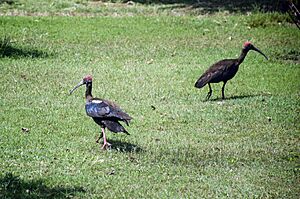
The number of red-naped ibises has gone down a lot in Pakistan because of hunting and losing their homes. However, in India, the species has mostly been okay. Farmers and people in cities traditionally don't bother them. Studies showed that levels of a chemical called DDT in their blood were very low, which is good news for their health.
Counting the number of red-naped ibises can be tricky because they often live in dry areas, not just wetlands where most bird counts happen. A careful study estimated their population to be around 2,081,800 birds. This makes the red-naped ibis one of the most common waterbird species found only in certain areas. Their numbers can change a lot with the seasons, making them hard to track. Even though most ibises look for food in dry places, more of them live in areas that have more wetlands. They don't seem to prefer wetlands of a certain size, but having a few large wetlands helps them in dry areas where smaller wetlands dry up in summer.
Studies in cities show that red-naped ibises can find food in urban areas and nest on man-made structures like light poles, even in busy markets. Red-naped ibises might be doing well because cities are growing, as long as there are still trees for them to nest in. This is especially true in dry areas where tall nesting trees are rare in the countryside, and people don't harm the birds. Even though growing more crops has led to fewer trees in many areas, red-naped ibises continue to thrive by using artificial nesting places like electricity towers and cell phone towers. These studies suggest that the red-naped ibis might be increasing in numbers because they are very adaptable. They can use many different habitats that humans have changed.
Some zoos, like those in Frankfurt and Singapore (Jurong Park), have successfully bred these birds in captivity. One ibis lived for 30 years in the Berlin zoo!




